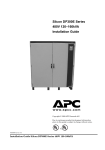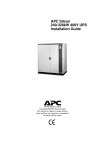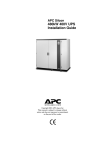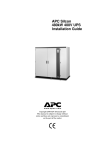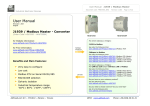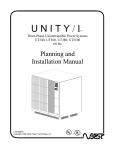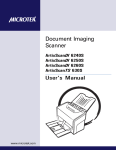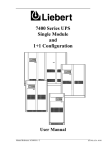Download American Power Conversion 240-320kW Power Supply User Manual
Transcript
APC Silcon 240-320kW 480V UPS Installation Guide Copyright ©2001 APC Denmark ApS This manual is subject to change without notice and does not represent a commitment on the part of the vendor. Thank You! Thank you for chosing an APC Silcon UPS. Please read this Installation Guide thoroughly prior to installing the system. It provides important information on safe and efficient installation. The installation and use of this product must comply with national, federal, state, municipal and local codes. Safety Symbols used in this manual WARNING! Indicates a hazard which, if not avoided, could result in injury or death. CAUTION! Indicates a hazard which, if not avoided, could result in damage to the product or other property. NOTICE! Read and pay attention to this important information. WARNING! This UPS unit contains hazardous AC and DC voltages. Only qualified electricians should install the UPS, AC line and external batteries, and must be familiar with batteries and battery installation. Before installing, maintaining or servicing the UPS, shut off the UPS and disconnect all sources of AC and DC power. As the UPS has no built-in disconnection devices to switch off external AC and DC input power, ensure that disconnection devices are provided as separate parts in connection with the installation! The installer must provide each external disconnecting device for this UPS system with labels with the following text: “Isolate the Uninterruptible Power Supply (UPS) as instructed in this guide before working on circuit”. AC and/or DC voltage will always involve a potential risk of AC voltage at UPS output generated from either batteries or utility. To avoid equipment damage or personal injury, always assume that there may be voltage at UPS output. This system is equipped with an auto-start function. If activated the system may start without warning. Refer to “Programming” section for information on de-activation. TEST BEFORE YOU TOUCH! To reduce the risk of fire or electric shocks, install the UPS and external batteries in a temperature and humidity controlled indoor area, free of conductive contaminants. UPS batteries are high-current sources. Shorting battery terminals or DC terminals, DC busbars can cause severe arcing, equipment damage and injury. A short circuit can cause a battery to explode. Always wear protective clothing and eye protection and use insulated tools when working on batteries. CAUTION! This unit contains components sensitive to electrostatic discharge (ESD). If you do not follow the ESD procedures, you may cause severe damage to electronic components. PLEASE RECYCLE The shipping materials for the APC Silcon UPS are recyclable. Please save for later use or dispose of them appropriately. 990-4049 2 Installation Guide APC Silcon 240-320kW 480V UPS Contents: 1.0 Introduction 1.1 Tools and Equipment 5 5 2.0 Unpacking/Identification of Equipment 6 3.0 Installation 3.1 Requirements on Site 3.2 Dimensions and Weight 3.2.1 Dimensions and Weight of UPS 3.3 Footprints 3.3.1 UPS Cabinet Footprints 3.3.2 Conduit Entrance Plate in bottom of the system 3.3.3 Top Cable Entry 9 9 9 9 10 10 11 12 4.0 External Connection 4.1 Connecting the UPS 4.1.1 Connecting AC and DC Power Cables (Dual Utility Connection) 4.1.2 Seperation of AC from DC1 and DC2 4.1.3 Top or Bottom Cable Entry 4.1.4 Dual and Single Utility Supply 4.1.5 Switching from Dual to Single Utility Input 4.1.6 Connection Terminals 4.1.7 Torque Specifications 4.1.8 Grounding 4.2 System Integration Interface 4.2.1 Connecting the System Integration Interface Board (SII-board) 4.3 Parallel Board 4.4 Relay Board 4.4.1 Relay Board Functions 4.4.2 Cable Sizes 4.5 Communication Interface / Smart Slot 4.5.1 Connections 4.6 SmartSlot for APC Silcon 240-320kW UPS 4.6.1 SmartSlot Accessories 4.6.2 Multiple SmartSlot Installation - introduction 4.6.3 APC Silcon Battery Cabinets 4.7 Battery Breaker Box 4.7.1 Interconnection 4.7.2 Mounting and Connection of Battery Breaker Box 4.7.3 UPS with External Battery via Battery Breaker Box 4.8 UPS Installations in Computer Rooms 4.8.1 EPO Principle 4.8.2 Emergency Power Off (EPO) for UPS 13 13 14 16 17 18 20 22 22 22 24 25 29 31 31 33 34 34 34 35 35 37 39 40 40 41 41 42 44 5.0 Programming 5.1 Parameters 5.1.1 Programming Keys 46 46 47 990-4049 Installation Guide APC Silcon 240-320kW 480V UPS 3 5.1.2 5.2 5.2.1 5.2.2 5.3 5.3.1 5.3.2 5.4 6.0 Programming Example - Switch to Bypass Operation System Configuration Programming Example - Change Boost Charge Voltage to 446V Programming Example - Change to Output Isolation Transformer Available Programming Parameters for Advanced Parallel Operation. Description of Settings. Programming Example Battery Monitor 47 49 50 51 52 52 52 53 Options/Accessories 6.1 Diagrams for Service Bypass Panel for Single Operation, Single and Dual Utility 6.2 Seismic Anchoring 6.2.1 Mounting Seismic Anchoring 6.3 NEMA 12 Cover (IP31) 6.3.1 Mounting NEMA 12 Cover 6.4 Remote Display 6.4.1 Extension of Remote Display Communication Distance 6.4.2 Remote Display Installation 6.4.3 Remote Display Use 6.5 Isolation Transformer Module 6.5.1 Requirements on Site 6.5.2 Cabinets and Dimensions 6.5.3 Footprints 6.5.4 Connecting Isolation Transformer 6.5.5 Recommended Cable Lugs and Crimping Tools 6.5.6 Isolation Transformer - Diagram Delta WYE configuration (Dyn11) 6.5.7 Isolation Transformer Grounding 6.5.8 Principale Diagrams for Isolation Transformer 6.6 Intersystem Synchronization Unit 54 54 62 63 64 64 65 65 67 68 69 69 70 70 70 70 71 71 72 74 7.0 System Specifications 7.1 Technical Data 75 75 8.0 Appendix 8.1 Table 1. Installation Planning Data 8.2 Table 2 – Table 310-16 76 76 77 9.0 Warranty 9.1 APC Silcon Series® Limited Factory Warranty 79 79 10.0 How to Contact APC 80 990-4049 4 Installation Guide APC Silcon 240-320kW 480V UPS Introduction 1.0 Introduction Power regulation varies from country to country, and the information given in this installation guide can therefore only be of a general nature. Electricians should always refer to national and local electrical codes prior to installing the UPS system. WARNING! Heavy equipment. To prevent personal injury or equipment damage, take extreme care when handling and transporting UPS cabinet and equipment. 1.1 Tools and Equipment This section lists all tools and equipment required to install all UPS configurations. See also section 4 for further details on connection. WARNING! Ensure that front doors are in place and that internal front cover is fastened by screws before attempting to lift or transport the system. Tools: • 10mm socket • 13mm socket-deep • 17mm socket • 3/4” or 19mm socket-deep • 3/4” or 19mm combo wrench • Small flathead/regular screwdriver • #3 philips screwdriver • Compression lug crimping tool • Knock-out set (for conduit) Equipment: • Compression lugs for cable terminations • Cable to Service Bypass Panel from system feeder • Cable to UPS input from service bypass panel • Cable to Service Bypass Panel from UPS output • Cable from Service Bypass Panel to customer distribution • Cable to UPS input from external batteries/external Battery Breaker Box (systems = with external battery) • Solid core, control wire to UPS from Service Bypass Panel • Solid core, control wire to UPS from external batteries/external Battery Breaker Box • Conduit necessary for above listed cabling 990-4049 Installation Guide APC Silcon 240-320kW 480V UPS 5 Unpacking/Identification of Equipment 2.0 Unpacking/Identification of Equipment NOTICE! Unless otherwise specified by the shipping company, use a fork lift to unload equipment from pallet. 1. Unpack system. 2. Verify compliance between type label on reverse side of front door and system ordered. Check input and output voltage. 3. Copy the type label data to label copy below for easy identification of the system. 4. Use a fork lift to transport the system to installation site. Copy of type label (without battery): 990-4049 6 Installation Guide APC Silcon 240-320kW 480V UPS Unpacking/Identification of Equipment Main UPS system The UPS is a battery back-up system. Unconditioned power is fed to UPS input. The UPS supplies conditioned power. Service Bypass Panel AC utility power for critical load is led through the service bypass panel while UPS is shut down for maintenance Battery Breaker Box The APC Battery Breaker Box is required if the UPS is installed with an external battery. The Battery Breaker Box provides overcurrent and short-circuit protection. Battery Cabinet For storage and protection of battery bank. 990-4049 Installation Guide APC Silcon 240-320kW 480V UPS 7 Unpacking/Identification of Equipment Isolation Transformer Isolation Transformers are used for galvanic isolation of utility power and conditioned power. Seismic Anchoring Seismic anchoring stabilizes the UPS in seismic areas. NEMA 12 Cover NEMA 12 covers are used in locations with potential risks of liquid discharge or leakage above UPS system. Remote Display Use remote display to monitor UPS NOTICE! Contact your local APC representative or APC Support if you have any questions 990-4049 8 Installation Guide APC Silcon 240-320kW 480V UPS Installation 3.0 Installation 3.1 Requirements on Site All system parts are accessible from front or top of UPS. Cable entries are accessible from top or bottom. The system may be installed close to walls as long as free space is allowed for system doors to open. For ventilation and service purposes allow for free space of a minimum of 3 foot above and in front of UPS. Never install systems in direct sunlight. WARNING! For safety reasons do not stand on UPS. Keep UPS cabinet surface free of any objects 3.2 Dimensions and Weight 3.2.1 Dimensions and Weight of UPS UPS Height inch/mm Width inch/mm Depth inch/mm Weight lbs./kgs 240kW 480V 70.86/1800 74.80/1900 31.50/800 4432/2014,5 320kW 480V 70.86/1800 74.80/1900 31.50/800 4432/2014,5 Cabinet 70.86/1800 in./mm 74.80/1900 in./mm wide 990-4049 Installation Guide APC Silcon 240-320kW 480V UPS 9 Installation 3.3 Footprints 3.3.1 UPS Cabinet Footprints NOTICE! Dimensions indicated in inches / milimeters and lbs. / kgs 74.80/1900 73.85/1876 COM DC UTILITY 1 71.05/1805 70.86/1800 62.20/1580 OUTPUT 59.44/1510 54.20/1377 UTILITY2 51.45/1307 REAR FRONT 42.40/1077 32.56/827 29.80/757 3.74/95 1.81/46 1.02/26 0 6.14/156 7.87/200 15.94/405 14.37/365 25.98/660 31.50/800 30.47/774 0.95/24 0 990-4049 10 Installation Guide APC Silcon 240-320kW 480V UPS Installation 3.3.2 Conduit Entrance Plate in bottom of the system REAR UTILITY 1 RIGHT LEFT 0 COM 30.39/771.9 DC 19.78/502.5 OUTPUT 10.14/257.5 UTILITY 2 COM FRONT Cable entries need to be punched in the UPS cabinet. Follow diagram for correct orientation of power and control cables to be led into the UPS. 990-4049 Installation Guide APC Silcon 240-320kW 480V UPS 11 Installation 3.3.3 Top Cable Entry Cable entries need to be punched in the UPS cabinet. Follow diagram for correct orientation of power and control cables to be led into the UPS. REAR 17.72/450 UTILITY 1-2/ OUTPUT/ DC 11.61/295 COM 7.68/195 RIGHT 26.12/663.5 16.28/413.5 3.31/84 0 LEFT 0 FRONT 990-4049 12 Installation Guide APC Silcon 240-320kW 480V UPS External Connection 4.0 External Connection 4.1 Connecting the UPS Prior to connecting the UPS, refer to section 6: Options and Accessories to ensure that UPS options are correctly interphased. WARNING! Read warnings on page 2 of this manual before continuing. To access cable terminals, open front door, remove screws and lift off the 4 front covers (remember earth wire on rear side). Power cable entry at bottom: Remove front covers 2 and 3. Power cable entry at top: Remove front covers 1 and 2. Remove cover 4. UPS system with cover– doors open 1 2 4 3 UPS system without cover and doors Connecting communication cables Connecting AC and DC power cables Connecting Ground NOTICE! Always keep AC, DC and communication cables separate. 990-4049 Installation Guide APC Silcon 240-320kW 480V UPS 13 External Connection 4.1.1 Connecting AC and DC Power Cables (Dual Utility Connection) Top bar – Utility 2 (L1, L2, L3) Bottom bar – Output (N/E, L1, L2, L3) Top bar – Ext. DC (X003±, X004±) Bottom bar – Utility 1 (N, L1, L2, L3) Connection in the bottom of the cabinet 990-4049 14 Installation Guide APC Silcon 240-320kW 480V UPS External Connection Dual Utility Connection Seen from front E L1 N L2 L3 Utility 2 – X002 Output – X005 L1 N L2 L3 Ext. DC Utility 1 – X001 Seen from side Utility 2 X002 Output X005 Ext. DC Utility 1 X001 WARNING! Bottom cabinet connection must be grounded. 990-4049 Installation Guide APC Silcon 240-320kW 480V UPS 15 External Connection WARNING! Supply the UPS from grounded 3-wire/4-wire WYE service. NOTICE! Ensure correct phase rotation of input voltage. NOTICE! Keep UPS input and output conductors in separate conduits. NOTICE! Keep AC and DC conductors in separate conduits. NOTICE! Keep batteries 1 and 2 (DC conductors) in separate conduits. WARNING! Keep UPS power conductors and UPS control wiring in separate conduits. 4.1.2 Seperation of AC from DC1 and DC2 Use the 2 pieces of polycarbonate (supplied with the UPS) to separate AC from DC1 and DC2. Standard length of polycarbonate adjusted for top cable entry. Adjust length of polycarbonate to fit bottom entry where applicable. Polycarbonate Polycarbonate 990-4049 16 Installation Guide APC Silcon 240-320kW 480V UPS External Connection 4.1.3 Top or Bottom Cable Entry For top cable entry, move copper angle bar to bottom. Unscrew bolt, take out the split, move the angle bar down, insert split, and tighten the bolt Angle bar 990-4049 Installation Guide APC Silcon 240-320kW 480V UPS 17 External Connection 4.1.4 Dual and Single Utility Supply WARNING! UPS units contain hazardous AC and DC voltages. Only qualified electricians should install UPS, AC line and external batteries, and must be familiar with batteries and battery installation. Before installing, maintaining or servicing the UPS, shut off the UPS and disconnect all sources of AC and DC power. As the UPS has no built-in disconnection devices to switch off external AC and DC input power, ensure that disconnection devices are provided as separate parts in connection with the installation! The installer must provide each external disconnecting device for this UPS system with labels with wording as follows: “Isolate the Uninterruptible Power Supply (UPS) as instructed in this guide before working on circuit” AC and/or DC voltage will always involve a potential risk of AC voltage at UPS output generated from either batteries or utility. To avoid equipment damage or personal injury, always assume that there may be voltage at UPS output. This system is equipped with an auto-start function. If activated the system may start without warning. Refer to “Programming Parameters” for information on de-activation. TEST BEFORE YOU TOUCH! To reduce the risk of fire or electric shocks, install the UPS and external batteries in a temperature and humidity controlled indoor area, free of conductive contaminants. UPS batteries are high-current sources. Shorting battery terminals or DC terminals or DC busbars can cause severe arcing, equipment damage and injury. A short circuit can cause a battery to explode. Always wear protective clothing and eye protection and use insulated tools when working with working near batteries. CAUTION! This unit contains components sensitive to electrostatic discharge (ESD). If you do not follow the ESD procedures, you may cause severe dammage to electronic components. The UPS is fitted with dual utility input as standard. If dual utility is not available or not needed, a small modification has to be made. See section 4.1.5 switching from dual to single utility input. 990-4049 18 Installation Guide APC Silcon 240-320kW 480V UPS External Connection Working Principle of Dual Utility (2 utility supplies) Q3 Utility 2 Output Q10 Q2 Q1 Utility 1 Utility 2 Utility 1 APC Silcon UPS NOTICE! Max. phase shift between utility 1 and 2: less than ±3. Refer to section 7.0 System Specifications for frequency tolerance of utility 1 and 2, and voltage. Utility 1 supports the load in normal operation. Utility 2 supports the load through the static and service bypass switch. Working Principle of Single Utility (1 utility supply) Q3 Utility 1/2 Output Q1 Q2 Utility 1/2 APC Silcon UPS NOTICE! Refer to section 7.0 System Specifications for frequency and voltage tolerance of utility 1. Utility 1 or 2 supports the load in normal operation or through the static service bypass switch. 990-4049 Installation Guide APC Silcon 240-320kW 480V UPS 19 External Connection 4.1.5 Switching from Dual to Single Utility Input Follow steps 1 and 2 to switch from dual to single input. In the static switch the following modifications have to be made for single utility input 1) Remove fiber bar (55322) by unscrewing bolts and by mounting copper bars as below Fiber bar Copper bars 2) Switch the connector in Con3 to Con1. 990-4049 20 Installation Guide APC Silcon 240-320kW 480V UPS External Connection CAUTION! Ensure correct phase rotation of utility input voltage! Max. power cable size: 500 kcmil. NOTICE! With a 3-wire input, the UPS can only be 3-wire loaded (Phase-to-phase). NOTICE! If an MCCB is used in stead of external input fuses, the MCCB load capacity must be 8xIn (nominal current) for min.10 ms. NOTICE! Gland plate in bottom of system must be mounted. Wiring Select wire size based on the data in Table 1, and the ampacities in Table 2 of this manual, a reprint of Table 310-16 and associated notes of the National Electrical Code (NFPA 70). See section 8.0 Appendix. Use commercially available UL approved solderless lugs for the wire size required for your application. Connect wire to the lug using tool and procedure specified by the lug manufacturer. Input, output and DC cables are routed in separate conduits. All AC cables rated 600V. DC cables for 480V systems rated 1000V unless otherwise stated. CAUTION! At a switch mode load of 100% the neutral must be rated for 173% output phase current. NOTICE! φ “phase” “risk of electric shock” Terminal for Equipment Grounding Conductor E Terminal for Grounding Electrode Conductor NOTICE! Terminals marked and are electrically connected to the terminal marked “E” NOTICE! For grounding, refer to local legal regulations. CAUTION! Read warnings on page 2 of this manual before continuing. 990-4049 Installation Guide APC Silcon 240-320kW 480V UPS 21 External Connection 4.1.6 Connection Terminals Terminals – 480V Terminal Type Input stud size Battery stud size Output stud size PE stud size System earth stud size 240kW M12 M12 M12 M10 M12 320kW M12 M12 M12 M10 M12 The terminals for the control & alarm cables are screw clamps for cable size AWG18 to AWG14. All other terminals are stud terminals. 4.1.7 Torque Specifications Stud size M6 M8 M10 M12 Torque 66/7.5 lb-in/Nm 133/15 lb-in/Nm 266/30 lb-in/Nm 443/50 lb-in/Nm 4.1.8 Grounding 4.1.8.1 System Grounding If no UPS neutral inputs are connected to a grounded service neutral conductor according to local NEC code reguirements, provisions must be made as follows: a) Bonding jumper must be mounted between output terminals X005:N and X005:E b) Output terminal X500:E, marked “Grounding electrode terminal”, must be connected by grounding electrode conductor to a local grounding electrode according to NEC 250-26 4.1.8.2 Equipment Grounding Terminals marked intended for equipment grounding. Provisions must be made as follows: Input equipment ground terminal(s) must be connected to grounding electrode(s) provided for the service entrance(s) 990-4049 22 Installation Guide APC Silcon 240-320kW 480V UPS External Connection E terminal Ground terminals 990-4049 Installation Guide APC Silcon 240-320kW 480V UPS 23 External Connection 4.2 System Integration Interface NOTICE! Refer to chapter 4.1.5 Changing from dual to single utility input Single Utility Dual Utility System Integration Interface (SII) is the control link between UPS and system main switches as shown above. The purpose of the SII is to ensure correct operation of switches without losing system output power. WARNING! Even with all AC and DC sources switches off, SII may receive high voltage from external alarm and signal circuit field wiring. 990-4049 24 Installation Guide APC Silcon 240-320kW 480V UPS External Connection Auxiliary contacts on the main switches transmit SII-board inputs. Lamps on Service Bypass Panel and Battery Breaker Box/Battery Cabinet indicate “green light” for operation of output switches. SII-board also integrates input facilities for emergency shut-down and temperature compensation of charge voltage for external battery (also used with battery monitoring). “Battery operation” and “Common fault” are the two main status SII-board relay signals. 4.2.1 Connecting the System Integration Interface Board (SII-board) SII Board X004 X003 X012 X005 S001 X001 S002 NOTICE! If the UPS is equipped with an Emergency Power Off (EPO) facility all input sources must be equipped with disconnecting devices. Terminal rows: X003 and X004 (auxiliary contacts) When switching Q001, Q002, Q010, Battery Breaker 1 or Battery Breaker 2 from “ON or 1” to “OFF or 0”, the auxiliary contact must open BEFORE the corresponding main contacts are opened. When switching Q001, Q002, Q010, Battery Breaker 1 or Battery Breaker 2 the opposite way from “OFF or 0” to “ON or 1”, the auxiliary contact has to close with a maximum delay of 0.5 seconds from the time the corresponding main contacts are closed. • This type of auxiliary contact is called a “late make” contact. (This also means that it will “break early” when activated in opposite direction) 990-4049 Installation Guide APC Silcon 240-320kW 480V UPS 25 External Connection • This auxiliary contact is also called “Normally Open” (NO), because the auxiliary contact will be open when the main contacts are open • Please note that the above term “NORMALLY” has nothing to do with NORMAL UPS OPERATION MODE When switching Q003 from “OFF or 0” to “ON or 1”, the auxiliary contact has to open BEFORE the corresponding main contacts are closed. When switching Q003 the opposite way from “ON or 1” to “OFF or 0”, the auxiliary contact has to close with a maximum delay of 0.5 seconds from the time when the corresponding main contacts are opened. • This type of auxiliary contact is called an “early break” contact. (This also means that it will “make late” when activated in the opposite direction) • The auxiliary contact is also called “Normally Closed” (NC), because the auxiliary contact will be closed when the main contacts are open • Please note that the above term “NORMALLY” has nothing to do with NORMAL UPS OPERATION CAUTION! All wiring to alarm and signal circuit fields to be rated 300V (minimum). X005 (output relays) The battery operation signal is received with a 30-second delay. This function is inactive during battery tests. Common fault relay facility is programmable (standard factory setting: 10 sec.) See APC Silcon User Guide for details. Maximum nominal voltage on contact circuits is 277VAC. If two different phases are involved, maximum phase to neutral voltage should be below 160VAC. Please note that phase L1 is already present on the System Integration Interface board, supplied from the Service Bypass Panel. Therefore, if a phase is needed for alarm or signal purposes, Phase L1 should be used”. Terminals X001, X003, X005, X004, X012: Cable size AWG18 to AWG14, use solid copper conductors only. 990-4049 26 Installation Guide APC Silcon 240-320kW 480V UPS External Connection 990-4049 Installation Guide APC Silcon 240-320kW 480V UPS 27 External Connection 990-4049 28 Installation Guide APC Silcon 240-320kW 480V UPS External Connection 4.3 Parallel Board CAUTION! Control cables must be separated from AC and DC power cables. Parallel Board The built-in parallel board connects two or more UPS systems in parallel, either to obtain increased system reliability or to obtain higher output power. The parallel board also ensures correct load-sharing between parallel systems. NOTICE! For reliability reasons, APC recommends separate battery packs in redundant/parallel configurations. To prepare the UPS for parallel/redundant mode, disconnect all sources of AC and DC power supply to the UPS and connect the ribbon cable from the parallel board to the main controller board. (The ribbon cable is delivered with the UPS). CAUTION! Do not connect ribbon cable in single configurations. Ribbon cable is for parallel operation only. Complete the parallel system set-up by connecting the external control cables (see below). Follow instructions in section 5.3 Programming of this guide to execute necessary reprogramming. 990-4049 Installation Guide APC Silcon 240-320kW 480V UPS 29 External Connection Parallel Board X020:15-pin SUB-D female X021:15-pin SUB-D female External multicore cable with 14 wires + shield to other parallel units UPS 1 UPS 2 UPS 3 External Control Cables External multicore cable has a 15-pin SUB-D male connector at either end. Connect pin 1 to pin 1, and pin 2 to pin 2 etc. up to pin 15 - except pin 8, which need not be connected. Shield is connected to plug cover at both ends. Terminals X020 and X021 for control cables are located on parallel board. Connect X020 in UPS1 to X021 in UPS2 and X020 in UPS2 to X021 in UPS3 etc. Connect X020 in last UPS to X021 in UPS1. (Cable is delivered with the UPS). Power Cables To optimize load-sharing in parallel operation, external power circuits must be “symmetrical”: Power input and output cables must have same length and identical cross-sections. 990-4049 30 Installation Guide APC Silcon 240-320kW 480V UPS External Connection 4.4 Relay Board Relays All relays are “fail safe”: In alarm modes, relay coil will be de-energized. Relay shown in alarm position 1 2 3 Maximum load: 8.0A – 250VAC 0.3A – 60VDC Minimum load: 0.05A – 6VAC 0.05A – 6VDC 4.4.1 Relay Board Functions NOTICE! If “communication to controller lost” alarm is active, ALL relays will indicate failure. Relay Number Message Alarm Trigging Events 1 ## (X002) Utility voltage RMS value outside tolerance Utility wave form (fast detector) outside tolerance Utility frequency outside limits Utility Outside Tolerance 990-4049 Installation Guide APC Silcon 240-320kW 480V UPS 31 External Connection Relay Number Message Alarm Trigging Events 2 ## (X003) Bypass Outside Tolerance Bypass voltage RMS value outside tolerance Bypass wave form (fast detector) outside tolerance Bypass frequency outside tolerance 3 ## (X004) Output Outside Tolerance Output voltage RMS value outside tolerance Output wave form (fast detector) outside tolerance Output frequency outside tolerance 4 (X005) System Overload Output load over 100% Delta inverter current limiter active Main inverter current limiter active 5 (X006) Fan Fault Blocked or faulty fan 6 (X007) High Equipment Temperature or Inverter Fuse Blown Static switch temperature too high Main inverter failure (temperature too high or fuse blown) Delta inverter temperature too high Magnetics temperature too high Isolation transformer optional temperature too high Battery temperature too high 7 (X008) Battery Breaker Box Battery OFF Battery Breaker Box battery OFF 8 (X009) Normal Operation UPS running in normal operation (Status) 9 ## (X010) Battery Operation UPS running in battery operation (Status) 10 ## (X011) Bypass Operation UPS running in bypass operation (Status) 11 ## (X012) Stand-by Operation UPS in stand-by mode (Hot stand-by, parallel systems only) 12 (X013) Service Bypass Operation Service bypass switch active 13 ## (X014) Boost Charge Operation UPS boost charging on battery 14 (X015) Battery Voltage Outside Tolerance DC voltage too high (shut down) DC voltage under warning level DC voltage too low (shut down) 15 (X016) Battery Condition Fault ABM detected battery weak ABM detected defective battery (ABM = Advanced Battery Monitor) 16 ## (X017) Common Fault All alarms as mentioned above (except relays 8+9+10+11) Internal power supply fault System locked in operation mode Internal memory fault Internal communication fault ## Delay programmable in XXXXXX stack “Common fault delay”. Settings 0,10,20,30 seconds. See section 5.2: System configuration in this guide. 990-4049 32 Installation Guide APC Silcon 240-320kW 480V UPS External Connection NOTICE! Alarm Trigging Events 1-2-3-9-10-11-13 activates the corresponding alarm relay after the delay. Alarm Trigging Events 4-5-6-7-8-12-14-15 activates the corresponding alarm relay momentarily. Common fault relay 16 is activated at the same time as relay 1-2-3-4-5-6-7-12-13-14-15, or in any of the below situations: • Internal power supply fault • System locked in operation mode • Internal memory fault • Internal communication fault 4.4.2 Cable Sizes Cable sizes 24 AWG - 12 AWG are suitable. Use copper conductors only. Cable sizes depend on current demand and ambient temperature. 990-4049 Installation Guide APC Silcon 240-320kW 480V UPS 33 External Connection 4.5 Communication Interface / Smart Slot The ComInterface having 2 ports - is used when an interaction between UPS and e.g. a computer system has to be established. The main purpose is to ensure monitoring and if needed, a controlled shut down of the computer in case of failures in the utility supply. 4.5.1 Connections Smart Slot X005, 25 pin SUB D female. ComPort 4.6 X008,25 pin SUB D male. Serial port RS232. For service use. SmartSlot for APC Silcon 240-320kW UPS A UPS system alone provides excellent protection from brief power problems. However, during an extended power outage an unattended computer system will eventually shut down due to battery capacity exhaustion. To prevent data corruption when the UPS shuts down, the computer must be informed by the UPS of impending shut down and take appropriate filesaving measures. This important function is called UPS monitoring. The UPS's computer interface port is the means by which your UPS communicates with a computer system. 990-4049 34 Installation Guide APC Silcon 240-320kW 480V UPS External Connection Some computer operating systems have built-in UPS monitoring. These systems require various hardware interfaces. Interface kits for all major operating systems that support UPS monitoring are available from your dealer. APC SmartSlot for APC Silcon Series UPS's has been designed for reliable and maintenancefree service in combination with your American Power Conversion (APC) Silcon UPS Series uninterruptible power supply (UPS). 4.6.1 SmartSlot Accessories SmartSlot at the front of the frame accomodate up to 3 accessory cards. Before installing any SmartSlot accessory, ensure it is a compatible "APC Silcon DUPSK" model. 1. Share-UPS TM, provides automatic shutdown of up to two additional servers. 2. Measure-UPS TM II, provides environmental information such as ambient temperature and humidity. 3. Call-UPS TM, works with an external modem to provide out-of-band UPS manegement 4. WEB/SNMP Management card, provides web based UPS management. 4.6.2 Multiple SmartSlot Installation - introduction If your UPS configuration uses more than one SmartSlot device, you must install them in the correct order for them to work together properly. Priority of SmartSlot devices: A SmartSlot device with higher priority is to be placed in the SmartSlort accessory slot with the higher number. Refer to the following table. Priority of APC accessories: Install SmartSlot accessories as dictated by the following table. An accessory with higher priority is to be placed in the accessory slot with the higher number. Acessory P/N Priority Position Web/SNMP Management Card AP9606S Highesst High-numbered slot Call-UPS® // AP9608 Second-highest Interface expander AP9607 Second-lowest Measure-UPS® // AP9612T AP9612TH Lowest Low-numbered Installing accessories – procedure To install accessories, perform the following steps: 1) Make sure that the APC Silcon UPS is powered off. 2) Install the Smart
















































































